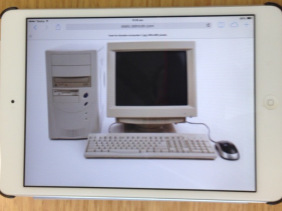
I started research on my Doctor of Education at the start of this year and have found that although I am reading so much and forming so many ideas, it’s really hard to actually start writing these down. After much procrastination and ‘note-taking’, I’ve decided that today is the day I start putting pen to paper and documenting what I’ve been ‘thinking’ about. After encouragement from my supervisors, I have decided to take my thinking public, and blog about my research as I go.
When I wrote my research proposal last year, I was hoping to develop a middle school approach to inquiry-based learning, using my current school as a case study. In order for readers to fully understand my ideas on this blog, I have included my proposal below as it outlines my initial ideas.
Proposal:
Research Topic: The design and implementation of an Inquiry-based learning Middle School pedagogical approach
Objectives of program of Research and Investigation:
Inquiry-based learning is essential in the development of a holistic and supportive curriculum that provides learners with the opportunities to direct their own learning in a twenty-first (21) century learning landscape. While inquiry-based learning is not a new concept, it has become the framework for learning in a society of innovation and the unknown. Often educators recognise the, “significant challenges we will face in today’s world, …[require] us to innovate, change, take risks, recognize problems and imagine alternate futures”, however, this is not always catered for across all disciplines (Barell, 2010, p.176). Education Queensland acknowledges that every school should have a research-validated pedagogical framework that is implemented and supported consistently across the school setting, with student-centred learning and evidence-based decision-making key principles in ensuring the success of learners (2013, p.1). The Australian Curriculum, Assessment and Reporting Authority, recognises Inquiry skills in its curriculum, however, does not mention inquiry-based learning. Essentially, it is up to the school itself to adopt a whole-school inquiry-based approach in order to accommodate for this. Without such an approach, educators may be teaching inquiry skills, without awareness or recognition of their relationship to inquiry-based learning. Thus, in order to successfully implement a curriculum focused on inquiry skills, it is necessary for a school to develop a systematic approach to inquiry-based learning that is transferable across each discipline.
Research methods: Research will be conducted using a case study methodology. Thus, data will be collected through interviews, questionnaires and observations of the staff and students at a secondary order-based Catholic School.
Case Study Site:
The site under investigation currently adopts an inquiry-based learning pedagogy, particularly in the middle school, with students completing a subject entitled Integrated Studies that incorporates the core subjects of English, Social Sciences and Religious Education. Theoretically, Integrated Studies is built around Kath Murdoch’s Phases of Inquiry model, however often, due to the unfamiliarity of teachers with the inquiry process, this is often overlooked and student’s are instead exposed to teaching and learning that focuses heavily on summative assessment and, the inquiry process and development of twenty-first century skills, are marginalised. In addition to this, not all departments are encouraging their staff to adopt inquiry-based learning, as they believe their disciplines are more suited to other approaches or, do not see the merits of inquiry-based learning. With the onset of a year seven (7) cohort entering the college in 2015, the college hopes to develop an atmosphere that actively incorporates an inquiry-based philosophy across all departments within the school. In order to be successful in this, the school needs to consider how current and future trends in learning, such as John Hattie’s Visible Learning, can be incorporated in the inquiry process and additionally, how the inquiry process, and the skills developed in this process, can be transferred across all departments and into the senior school. The staffing, professional development programs and practices of teaching and learning within the school need to be assessed so that all learning within the school models a singular inquiry-based learning approach.
Prior Research:
With the rapid advancements in technology, the transformation of literacy and the constant bombardment of information that twenty-first century learners are faced with, it is evident that a change is need in our teaching styles to effectively cater for today’s learners. The concept of inquiry-based learning, whereby students become active participants in locating and using a range of information sources to construct their own understanding of a problem or issue, is one appropriate student-centred response that attends to the needs of twenty-first century students (Kuhlthau, Maniotes & Caspari, 2007, p.2). Often in the twenty-first century, students are presented with tasks that require them to research and draw on a range of information sources to construct their knowledge independently without guidance (Todd, 2006, p.6). By incorporating inquiry learning, teachers are able to guide students through the process of locating and selecting appropriate information and assist them in developing the skills needed to transform information into knowledge.
Inquiry-based learning is modelled on the constructivist theory that allows a student to be an active participant in the construction of deep understanding and learning. Early Constructivists, such as John Dewey, argued that education involved creating new knowledge through an inquiry process. He advocated a Reflecting Thinking process that allowed for reflection in each stage of understanding and learning (1915, p.158). The concept that learners actively reflect on new information in the learning process and then form their own ideas that lead to deep understanding, is the foundation of inquiry-based learning (Kuhlthau, et al., 2007, p.15). This, coupled with research that suggests the brain runs on emotions that drive thoughts and actions which are increased when a learning environment is challenging, social and engaging, is the focus of guided inquiry: to challenge students to become engaged in their own quest for knowledge and understanding through personal and social construction (Kuhlthau, et al., 2007, p.15). There are numerous pedagogical approaches to inquiry-based learning, however, essential to these approaches is the need to contain a combination of three key elements: a questioning framework, an information seeking process and an action research cycle, in order to contain an authentic student-centred approach (Lupton, 2012, Para. 1). Thus, as Barell suggests, it is integral that we recognise inquiry is a, “natural outcome of encountering situations characterized by doubt, difficulty, complexity, novelty, conflict and mystery” (Barell, 2009, Loc 460).
Inquiry-based learning is an effective active learning pedagogy. Harste suggests that incorporating inquiry-based learning involves changing the way we view instruction, so that curriculum is focused on the personal and collective questions of the learners (2001, p.3). This is supported by Schuster’s discovery that incorporating inquiry learning into her courses allowed her student’s to discover that their knowledge was valued and essential to their own learning (2008, p.176). By transforming her classroom from a teacher-centred environment with prescribed textbooks that provided students with answers, to a student-centred environment that allowed active learning through research, discussion and analysis, Schuster found that her students were equipped with skills that promoted life-long learning (2008, p.177). Similarly, Fitzgerald found in her case study on inquiry learning in a classroom setting, that students achieved more when their own research and inquiry provided direction and guided the final result (2007, p.35). Thus, it is evident that a learning experience that embraces inquiry-based learning, will allow students to construct their own meaning and become active and engaged learners as they share responsibility in the direction and outcome of their learning.
While it obvious that students benefit from the flexibility they have in building and developing their knowledge and understanding, the inquiry process must be supported by a flexible team of educators who assist the students in developing their research and information literacy skills (Kuhlthau & Maniotes, 2010, p.18). Kuhlthau and Maniotes argue that, as the implementation of inquiry learning is complex and multi-faceted, it is essential to develop a team of experts with a range of expertise who will supervise and assist students in their inquiry (2010, p.19). Kuhlthau and Maniotes identify five kinds of learning in the inquiry process: curriculum content, information literacy, learning how to learn, literacy competence and social skills (2010, p.19). By creating a team of educators that will assist students in these areas of learning, a unit will be fully utulising the expertise of the school community. Todd asserts that a team of educators who assist students in carrying out and scaffolding their inquiry, ensures that evidence of student learning can be gathered and, “provide a mechanism for teachers and school librarians to recognise those critical moments when intervention and instruction is essential, and then to tailor interventions to enable students to achieve successful outcomes in their inquiry” (Todd, 2006, p.6). Therefore, it is essential that inquiry-based learning needs to be planned, negotiated and supervised by an instructional team who are able to guide, support and enable students to become effective researchers, information users and seekers, as well as constructors of their own knowledge.
It is apparent that inquiry-based learning is an effective and logical teaching and learning approach, as it allows for students to be active participants in the construction of their knowledge in an engaging and social process. By creating an instructional team that caters for the content and skill needs of the learners as they learn, students will be able to achieve outcomes that utilise the information literacy skills needed to be active participants in the twenty-first century technological society. Inquiry-based learning greatly enhances the learning experience of students and should be considered and catered for in twenty-first (21) century pedagogy.
If you are someone who is interested in pedagogy that is supported across disciplines in a whole-school approach, particularly inquiry-based learning and movements such as Visible Learning, please follow my blog and join the conversation as my ideas and research grow.
Reference list:
Barell, J. (2008). Why are school buses always yellow?: teaching for inquiry, preK-5 [Kindle edition]. Retrieved from http://www.amazon.com/School-Buses-Always-Yellow-ebook/dp/B00AFFRRY2/ref=sr_1_1?s=digital-text&ie=UTF8&qid=1382839480&sr=1-1&keywords=john+barell
Barell, J. (2010). Problem-based learning: The foundation for 21st century skills. 21st century skills: Rethinking how students learn, 175-199.
Dewey, J. (2004). Democracy and education. Courier Dover Publications.
Education Queensland, Department of Education, Training and Employment (2013). Pedagogical framework – at a glance. Retrieved from http://education.qld.gov.au/curriculum/pdfs/pedagogical-framework-a-glance.pdf
Fitzgerald, L. (2007). Investigating guided inquiry: a beginning. Scan, 26(2), 30-37.
Fitzgerald, L. (2011). The twin purposes of guided inquiry: guiding student inquiry and evidence based practice. Scan, 30(1), 26-41.
Gillon, K. & Stotter, J. (2011). Inquiry learning with senior secondary students: yes it can be done! Access, 25(3), 14-19.
Harste, J. (2001). What inquiry is and isn’t. In S. Boran & B. Comber (Eds.), Critiquing whole language and classroom inquiry (pp. 1-17). Urbana: National Council of Teachers of English.
Kuhlthau, C.C. & Maniotes. L. K. (2010). Building guided inquiry teams for 21st-century learners. School Library Monthly, XXVI(5), 18-21.
Kuhlthau, C. C., Maniotes, L. K. & Caspari, A. K. (2007). Guided inquiry: learning in the 21st century. Westport, CT: Libraries Unlimited.
Lupton, M. (2012, August 22). What is inquiry learning? [Web log post]. Retrieved from http://inquirylearningblog.wordpress.com/2012/08/22/what-is-inquiry-learning/
Murdoch, K. (2010). Phases of inquiry. Retrieved from http://www.kathmurdoch.com.au/uploads/media/phasesofinquiry.pdf
Schuster, L.A. (2008). Working-class students and historical inquiry: transforming learning in the classroom. The History Teacher, 41(2), 163-178.
Todd, R. J. (2006). From learning to read to reading to learn: school libraries, literacy and guided inquiry. International Association of School Librarianship. Selected Papers from the… Annual Conference, 1-18. Retrieved from http://search.proquest.com/docview/236087169?accountid=13380


![Five differently-coloured paperclips joined together into a chain. [Photograph]. Retrieved from Encyclopædia Britannica ImageQuest. http://quest.eb.com/#/search/118_797605/1/118_797605/cite](https://learningthroughinquiryblog.wordpress.com/wp-content/uploads/2014/09/118_797605-w.jpg?w=640&h=393)




